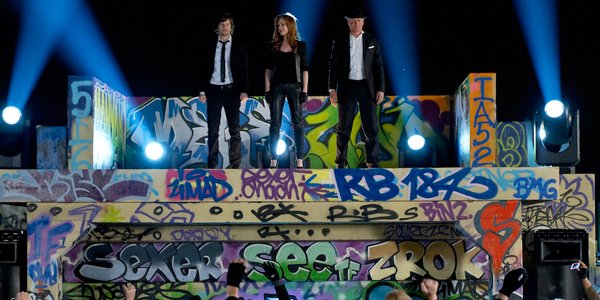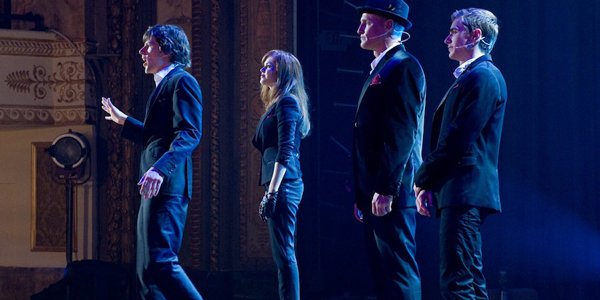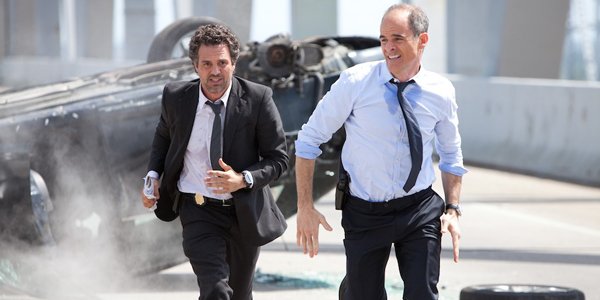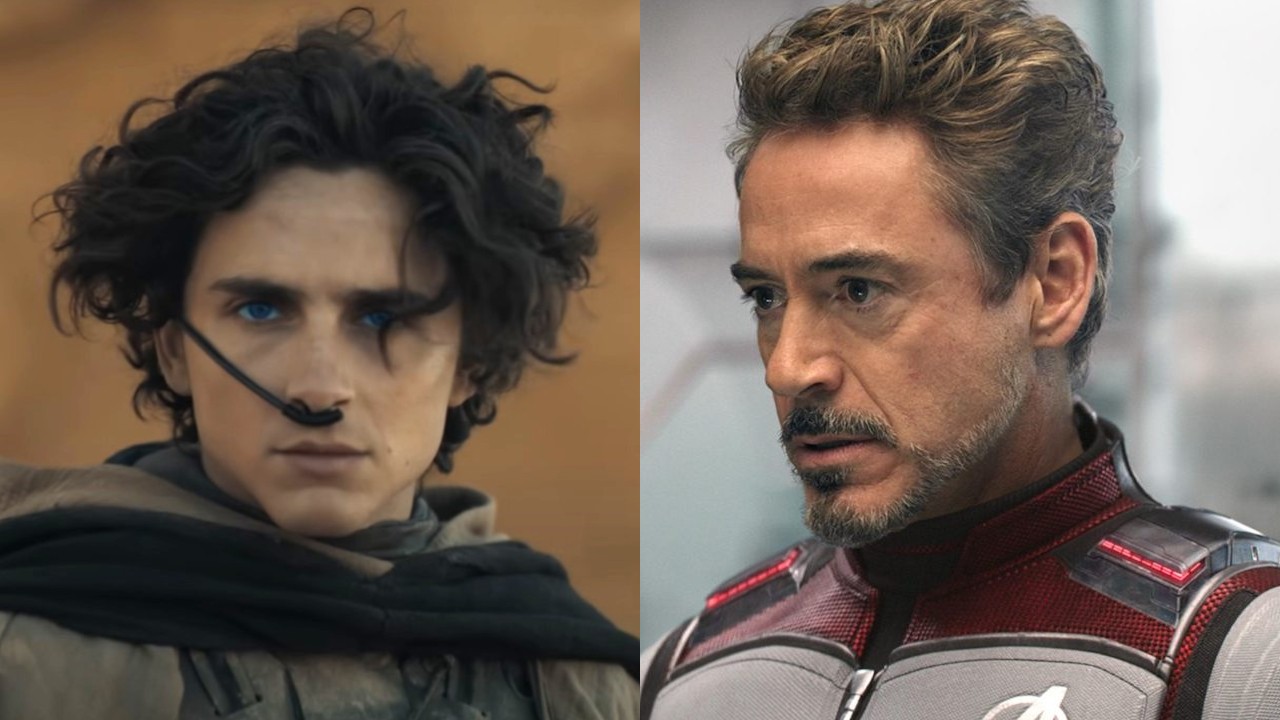On The Set Of Now You See Me, Where Everyone Has A Trick Up Their Sleeve

Though movie productions have been faking New York City locations for decades, there are a few things you simply can't fake. Like an abandoned building that's become a legendary graffiti hub, painted over by countless artists and preserved by devoted caretakers. Or views of Manhattan from the top of the building where your characters will pull off their climactic stunt. Or the 7 train rumbling by in the background, loud and chaotic but all part of the charm you get when you sign up for New York City.
On a chilly night in Long Island CIty, Queens last spring, the production of Now You See Me had set up at the iconic 5 Pointz, where the magicians at the center of the story were ready to pull off their big climactic illusion. With a crowd gathered below them, and both an FBI agent (Mark Ruffalo) and an Interpol agent (Melanie Laurent) hot on their tail, the Four Horsemen-- played by Jesse Eisenberg, Isla Fisher, Dave Franco and Woody Harrelson-- were standing on the roof of 5 Pointz and commanding the crowd. Or were they? As the crowd looked up in awe, Ruffalo's character was led in the opposite direction by Laurent's, each of them trying to stay ahead of the magicians who had eluded them all this time. Were they on the roof, or was that another illusion? Would the magicians and Robin Hood-like thieves be caught in the end?
Nobody on the set was telling-- that's the nature of a set visit, where you see one piece of a very large puzzle that will only make sense in context. But in the night spent at 5 Pointz, watching director Louis Leterrier manage 650 extras and tossing his actors right into the middle of them, we saw a film about something that might sound ridiculous-- a bunch of magicians who rob banks and share their profits with the audience-- turning into something thrilling. Leterrier, who has made The Incredible Hulk and Clash of the Titans, says that Now You See Me is his small movie, and operating on an estimated $70 million budget with limited CGI, it's a good bit smaller than his last two films. But as he stood on set, describing shoots in Las Vegas and New Orleans, using the crowd on Bourbon Street as free extras and inventing new shots inside an elevator shaft, it's clear that "small" for Louis Leterrier is still a pretty damn big spectacle.
Truthfully, it was hard to tell just how much spectacle that would be on the ground at 5 Pointz, especially with Leterrier and producer Bobby Cohen both being deliberately cagey about what they would reveal (asked why the Four Horsemen were robbing banks to begin with, Cohen said "I'd rather not tell you.") Leterrier revealed that some of the graffiti at 5 Pointz had been altered-- with permission of course-- so that it would be able to change as part of the magic trick, but of course we couldn't see that happen. As the extras looked up at the roof over and over again, they were supposed to be seeing the 4 Horsemen… who weren't there (their scenes had been shot earlier). And though the set was littered with fake money as part of the trick, nobody would reveal if the Horsemen were successful or not, or if Ruffalo finally succeeded in catching the magicians who had been eluding him across several cities.
At the same time, there were bits of verisimilitude all over the place, like the 7 train that rumbled overhead (Leterrier seemed practically giddy that he had gotten the subway "for free" instead of having to create it in CGI), or the warehouse next door that was crammed full of the iconic quilted food carts that rattle into Manhattan every morning. Before the production set up shop in 5 Pointz they had no idea the warehouse was there, but quickly incorporated the setting into a foot chase scene. As Cohen told us, "That's the kind of thing that you say, if you had written it that way, and said "Yeah, we should go and order 25 of those carts," somehow it would never quite look right."
Talking to the cast and crew on Now You See Me was a bit like spending time with a magician, watching them seem to reveal their entire hand-- Leterrier happily showed us footage on his monitor, and Ruffalo talked about the seductive power of magicians-- only to come back with 10 times as many secrets. Of course, that misdirection is all part of the plan, even for the audiences who wind up buying tickets.. "If we've done it right, I think that the whole movie should work as a trick," Cohen told us. So while we didn't come away with the method behind the magic, or even how Dave Franco got so good at tossing cards he was able to slice a banana in half with one from across the room, we were able to talk to the cast and crew about the practicalities of shooting a film in four different cities, about pulling one over on the audience, about honoring the spirit of magic and about the unexpected Zombieland reunion that happens when you cast Jesse Eisenberg and Woody Harrelson together.
You can read excerpts from our on-set conversation with Leterrier below, and come back later today for what we learned from Eisenberg, Fisher and Ruffalo. Check out the film's trailer first (you can see a lot of 5 Pointz graffiti in there), and look for Now You See Me in theaters on May 31.
Your Daily Blend of Entertainment News

NOW YOU SEE ME DIRECTOR LOUIS LETERRIER
What are we going to see specifically tonight? What are you filming?
We are doing the moment when all the cops have converged on the last show. They know where the magicians are, they’re a little ahead of them, they’ve always been behind them, but now they’re ahead, and they will arrest them. There’s a moment when one group of cops is going where the show is, and Melanie Laurent stops Mark Ruffalo and says, “Come the other way, trust me, come this way, I’ll show you, towards this crappy pushcart, this food cart thing, that’s where they are, that’s where we can stop them, that’s where we can come ahead.” And he has that moment where he hesitates, and he’s like, should I trust her? Because they’ve been trying to work together, but sometimes she was — it’s two people working together for the first time, being attracted or being mistrusting and everything. So that’s the moment where really, it’s the crossroads between, do I go with these guys and keep my job, or do I risk losing it all and go with her?
How do you deal with the trains when they’re going overhead?
Oh it’s fine, the trains have been great. It’s free. We have a scene on Bourbon Street where Mark Ruffalo chases them, and we’re like, okay we need extras. We can only afford whatever, like two hundred. And I was like, with the AD, let’s go on Friday night and shoot on Bourbon Street. So we had twenty thousand free extras. And we have, you know, free trains. We did some amazing shots the other day with the helicopter with the trains. It’s amazing. People will see that, and that’s the thing, people will be like, “Visual effects.” I’m like, “No, that’s real, that’s real, let’s find a real location, that’s real.” No, it’s fine, you do that and then you loop.
Why was this location so perfect for the scene?
Because visually, we wanted a place where thousands of people could converge, New York in the background, several floors, a maze. That’s what I was looking for. It’s a cat and mouse game that ends up in this location. You’ll see afterwards in the 4D projection, there’ll be helicopters flying around with spotlights and the spotlights will shine on the building, almost doing an X-ray transparency thing where you’ll see the magicians running around and the cops chasing them. All that stuff will be projected onto the building. This is a great building, this is unbelievable.
Did you recreate some of this on a soundstage?
No, actually, it’s all here. We didn’t do a lot of soundstage. We built an apartment just because it’s easier to film fly away walls and everything, but our thing was, let’s shoot on location as much as possible. So we went to New Orleans, you know, for the tax incentives, yes, but I said, well, it’s New Orleans. It’s magic and voodoo and all that stuff, so let’s really embrace New Orleans for what it is. So we shot New Orleans for New Orleans, we’re shooting New York for New York, Vegas we’re going next week, and then Paris at the end. So yeah, we’re going to the real places. We’re shooting in real places.
It looks like you're trying to capture a lot of stuff in-camera instead of relying on CGI.
Yeah, absolutely. I’m trying to get as much as possible real stuff. Then afterwards we’ll do crowd replications. It’s not crazy visual effects, it’s crowd replications and stuff like that. There’s no full CG shot. Again, it’s putting stuff together, putting elements together. But I still try to get the stuff. Like the rig we have upside down. Yesterday we did a shot — I’ll try to find it — but we did the most amazing shot ever. It’s called a basket cam, we invented this. Literally, it’s a camera, a seamless 235 camera, going up a shaft with people, with a SWAT team running up. It’s as low-tech as possible, but it looks like a visual effects shot. I’ve done it before in Hulk, but it was a full visual effect. This time, I was like, “No no, let’s do it for real, I know how we do it, we do it for real.”
What was it about this project that said, I need to make this?
I was looking for a great script. And then the vision comes afterwards. But I don’t want to have just the title or universe, I wanted a great script with a great story, some great twists, some great characters. I was looking for it, looking for it, looking for it, and then I found this amazing script. It’s been written and enhanced, but it was already amazing in the beginning. So I was like, “This is it, this is for me.” And really, I’ve always loved magic and been a great admirer of magic, but respectful and fearing magic, because I was like, oh, I don’t just understand how you guys do it. And what I love about this script is that it’s very respectful of the art of magic but also gives you a little bit of a peek behind the curtain, the Wizard of Oz curtain, a little bit. Not too much, but that’s what I want.
We’ve seen other movies like The Prestige that tried to show magic, and audiences sometimes are like, “Well, it’s all a special effect.” So how do you deal with that aspect of today’s film-going world?
By having the actors doing it for real. You met [magic consultant] David Kwong yesterday, he’s a magician, and the actors have been doing the real deal, training and the real stuff. Obviously they cannot do everything, but the magic they’re doing is very real. Dave Franco has become amazing at throwing cards. He can take a card and throw it across the room. You met Steve Pope, the stunt guy, he slit his eye, above his eye, with a card across an entire theater. They really got amazing at it. And Woody has been training with this mentalist called Keith Barry. I don’t know if you know him, he has a TV show on Discovery. And really has been that close to hypnotizing people. But you know, hypnosis is very tough, mentalism is very tough, because you can actually make somebody go down, and if you don’t know how to bring them out, you can actually really be in trouble.
? What was the one magic trick that was most difficult to film?
?The card tricks are tough. We had some very complex stuff. We really had some very complex technical stuff, like mirrors. Sometimes, literally, the crew didn’t know what they were shooting. I knew ’cause I was like, this will be used to do this. But sometimes we’re inside a mirror, upside-down, reversed, and the guy on the crane was like, I don’t know where I’m at. Just take the wheels.
How would you say the project has changed or developed since you first signed on?
It’s become a little bit bigger, but not so much. I started like, oh, this is my small one, and then it became a little bit bigger just because the magic became bigger. Jesse Eisenberg as the leader of a magic group — that changed the whole dynamic as the script was written. The script was written for a David Blaine character, a guy wearing a T-shirt, in the original script, hitting on women and doing all this stuff. Jesse coming in was very different. So that’s one change, I guess, but it’s by meeting people, not me saying, “I want to do that.” Meeting people, and seeing that that would be the dynamic I wanted. Again, it was very healthy; the development process was very healthy on this one. It was a great script, then we get a great cast, then we rewrite the script for that cast, and then we build it up from there, starting with visual effects and stunts, finding locations, finding this kind of location, costumes, everything.
You're shooting with anamorphic film, even as a lot of people are going digital. What inspires you to stick with film?
I’ve always shot on film, or we shot on anamorphic lenses. Actually, these lenses that you see are very old, very old lenses, they’re like 40 years old. I feel like digital right now is getting better, because of the new camera that came out, it’s called the Alexa Studio, so now it’s really good. But three months ago when we started this movie, this camera didn’t exist. And I thought that without this camera, the image I would get would be too digital, too crisp. I mean, we’re shooting every format on this movie. We’re shooting digital. You weren’t here the other day, but the helicopter was shooting Alexa, we’re shooting with 5Ds, we’re shooting with GoPros, I’m shooting tons of formats. But the main format is film, 35 and anamorphic, just because of these reasons. Because it’s a film for me, it’s a feature film.

Mark Ruffalo and Melanie Laurent have both directed movies. Did that make them easier to work with?
They take direction easy. And when they see me, they’re like, “Oh, I know what he’s feeling.” Like the first shot of the day when the sun is rising. Or “Oh, I still have sixteen shots in a day.” Morgan Freeman has directed a lot of movies, so he knows exactly. Great actors are so easy to direct. It’s like they’re big 747s that you just have to move left and right, and I don’t really need to direct. I need to put them in the right costume, with the right haircut, in the right location, and with the right actor to act with. My job is almost done at this point, because I’ve found the perfect — it’s like cooking, it’s like cuisine. You cannot make a great dish with bad ingredients. I have great ingredients, and I’m putting them together. That’s all I’m doing.
What's the tone of the movie. People were mentioning Sneakers, Ocean’s Eleven. What are you thinking for the tone of the film and did you ask the cast to maybe watch any films, or did you watch any films before starting?
Yeah, obviously I watched Sneakers, Ocean’s Eleven, Usual Suspects, and all these movies, these heist movies. But for me, the movies I was giving my actors were more like French movies, just for the filming stuff, French movies. There’s a movie actually Melanie is in, called The Beat My Heart Skipped, it’s an unbelievable movie. It’s a remake, actually, of an American movie, James Toback’s Fingers. But there’s a levity about the camerawork that is really inspiring. I was talking to actors, I was like, here is how my camera is going to interact with you. You will be free, and I will capture moments, but it’s not going to be about the camera.
Because I was afraid they’d be like, ugh, the guy from Clash of the Titans is trying to direct me to say these big lines, and it’s going to be terrible. But I was like, “No no no, I’ve done these big movies, but really what I’m trying to do with this one is really to put you in the right mind or space, and then capture these great moments. Put a great group together and capture these little moments. I’m not trying to impose my style on a new film, like it’s just my toy. I’m not interested in this.” So that’s what I show them. It didn’t really have anything to do with the movie or the tone. Yeah, this movie, the tone is funny. All these people, they’re fast. Everybody’s having a great time, off-camera but on-camera too. It’s really fun, fast. It feels stupid to say that, but it really is like a thrill ride. It’s really fun and fast. The movie starts first heist seven minutes into the movie, and then you go in and never stop.
Staff Writer at CinemaBlend

